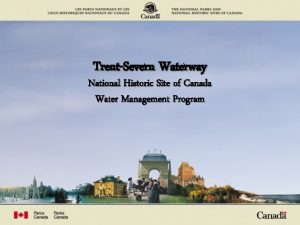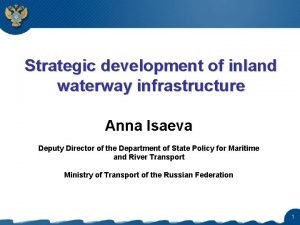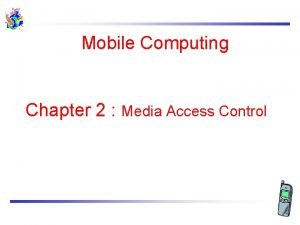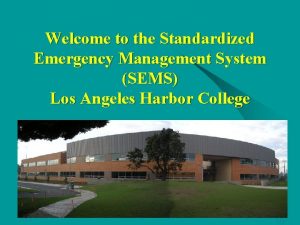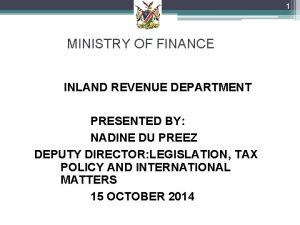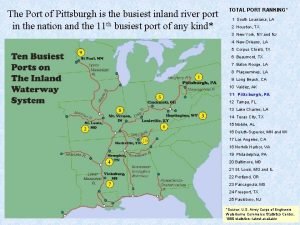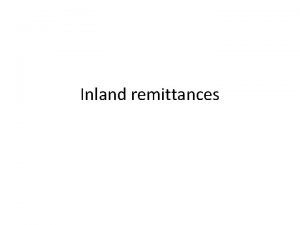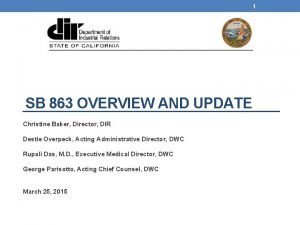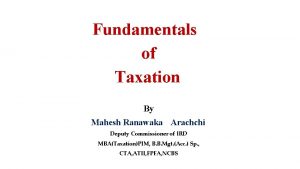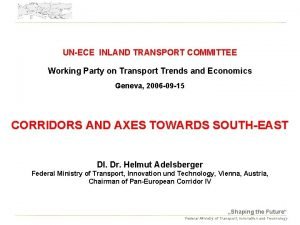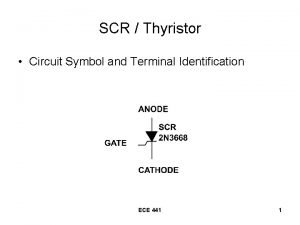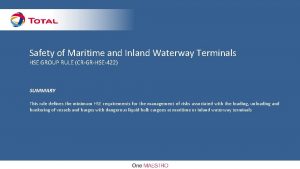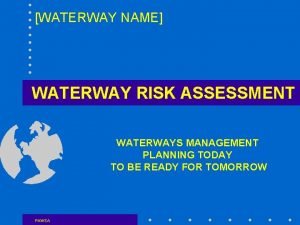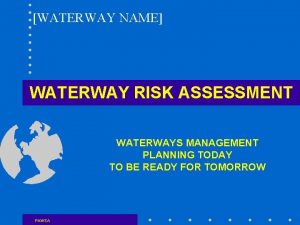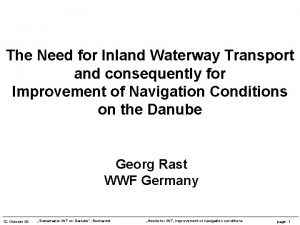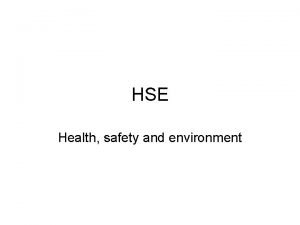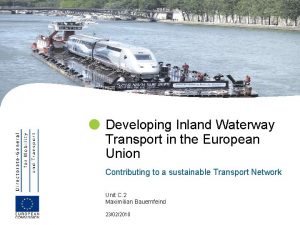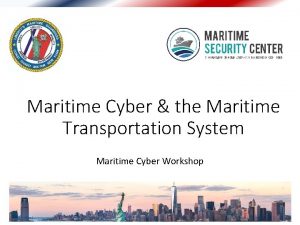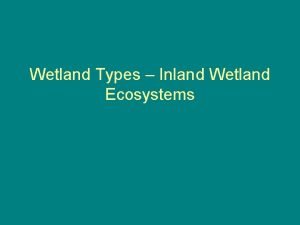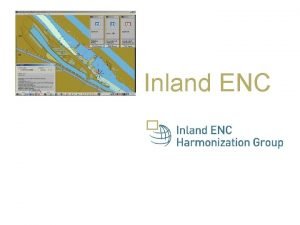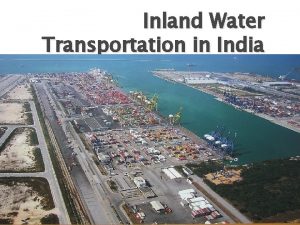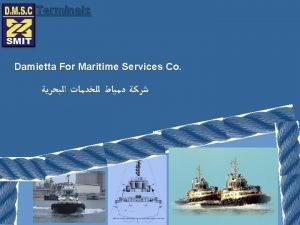Safety of Maritime and Inland Waterway Terminals HSE




















- Slides: 20

Safety of Maritime and Inland Waterway Terminals HSE GROUP RULE (CR-GR-HSE-422) SUMMARY This rule defines the minimum HSE requirements for the management of risks associated with the loading, unloading and bunkering of vessels and barges with dangerous liquid bulk cargoes at maritime or inland waterway terminals TOTAL Classification: Restricted Distribution TOTAL - All rights reserved

CR-GR-HSE-422 q Context: Activity in Total’s Oil & Gas terminals ü Maritime : 49 terminals - 70 Mt/y – 1800 calls/y ü Inland Waterways : 27 terminals - 13 Mt/y – 5500 calls/y q Scope: all entities of the operated domain q Defines 15 requirements, grouped into 3 themes: ü ü ü Identification of Risks Risk Control Measures of fire / Explosion, mooring failure, loss of containment, drowning Training, Emergency Response Plan, HSE Event Reporting, Self Assessment q Remplacing branch document : ü CR MS HSE 640 Marine and Inland Waterway Terminal Safety q Date of publication in REFLEX: 30/09/2020 q Effective date: 31/12/2020 TOTAL Classification: Restricted Distribution TOTAL - All rights reserved

REQUIREMENTS RISK MANAGEMENT Requirement 3. 1. 1 : HSE Risk Identification Operations related to the loading, unloading and bunkering of vessels and barges with dangerous liquid bulk cargoes in terminals undergo an HSE risk identification exercise that factors in at least: § The nature of the substances transferred; § The metocean conditions; § The phases of activities listed in Appendix 1; § The potential interfaces with co-activities, including nearby maritime or inland waterways traffic. Clarifications (HSE risks and associated phases of activity) The risks are identified by specific studies carried out during the design stage, supplemented by hazard identification studies (HAZID) and operational hazard identification studies (HAZOP), and updated regularly during the life cycle of the installation. At the end of these studies: § The proposed risk controls give priority to the implementation of prevention means, mitigation measures and to the rapid detection of incidents, in order to activate emergency plans as quickly as possible when necessary; § The technological risks identified are managed in compliance with CR-GR-HSE 301. TOTAL Classification: Restricted Distribution 3 TOTAL - All rights reserved

REQUIREMENTS Phases of Activity to be considered in Risk Identification. § Nautical access to the terminal (where applicable – usually the responsibility of the port authority); § Berthing and/or mooring, including double banking with another vessel or barge; § Access routes for personnel on board; § Transfer operations, including during transition periods (at the beginning or end of (un)loading, transhipment and/or bunkering operations); § Connection and disconnection, purging/draining of cargo transfer and/or vapour return equipment; § Gauging and/or sampling; § Recovery of vapours from the vessel or barge unit to the terminal (where applicable) TOTAL Classification: Restricted Distribution 4 TOTAL - All rights reserved APPENDIX 1

REQUIREMENTS MEASURES TO CONTROL FIRE AND EXPLOSION RISKS Requirement 3. 2. 1 : Hazardous Area Classification Areas of the terminal facilities where potentially explosive atmospheres may occur are classified according to local regulations, or failing this, according to the requirements of the European ATEX Directive no. 1999/92/EC or of the international standard IEC 60079 -10 -1. In particular: Main modification (no hazardous area classification mentionned into the previous CR) Applied in all terminals? Diagrams (plan and elevation views) show the hazardous areas; Warning signs are placed at the entrances to areas where explosive atmospheres can form; The electrical, electronic, telephone, and radio equipment (VHF/UHF) used or likely to be used in these areas are certified; The hand tools used in these areas are designed and adapted to reduce the risk of sparks, particularly when connecting and disconnecting hoses or arms. TOTAL Classification: Restricted Distribution 5 TOTAL - All rights reserved

REQUIREMENTS Requirement 3. 2. 2 : Electrical Isolation of Connection Elements Between the vessel or Barge and the Terminal EW N In areas with potentially explosive atmospheres, electrical insulation is provided on all the connecting elements between the vessel or barge and the terminal, including arms, hoses, gangways and access walkways, fendering systems and mooring lines in order to avoid any risk of electric arcs. The effectiveness of this insulation is checked on a regular basis. New requirement for all branches based on a specific study and recommended by O&G industry Electrical insolation of the arms => insulation flange. Electrical insolation of hoses => insulation flange or an electrically discontinuous hose string. Bonding cables are not an effective means of dissipating potential differences between the vessel or barge and the terminal. They are used only when required by local regulations. TOTAL Classification: Restricted Distribution 6 TOTAL - All rights reserved

REQUIREMENTS MEASURES TO CONTROL FIRE AND EXPLOSION RISKS Requirement 3. 2. 3 : Protection Against the Risks Related to Static Electricity During the Loading Phases of Non-inerted Tanks The initial and maximum transfer flowrates of products that accumulate static electricity in non-inerted tanks of a vessel or barge are determined, and this information is exchanged before the transfer between the vessel or barge and the terminal. linear transfer velocity is limited to a maximum of 1 m/s at the individual tank inlets during the initial phase of loading Clarification then limited to maximum 7 m/s. No significant change Applied in all terminals GPL TOTAL Classification: Restricted Distribution 7 TOTAL - All rights reserved GNL Not applicable to the loading of liquefied gas on vessels or barges gassed-up tanks.

REQUIREMENTS MEASURES TO CONTROL THE RISK OF MOORING FAILURE Requirement 3. 3. 1 : Mooring of the Vessel or Barge Taking into account the metocean conditions and physical phenomena associated with maritime or inland waterway traffic passing nearby, the terminal ensures that for each berth and for different sizes of moored vessel or barge the following is defined: § Minimum under-keel clearance (UKC); § Minimum mooring requirements and performance criteria; § Additional measures to control the risk of mooring failure and the associated potential consequences, where appropriate. In order to do so: Clarification • Applied in all terminals • Access to maritime and inland waterway expertise already in place TOTAL Classification: Restricted Distribution 8 TOTAL - All rights reserved • Metocean limits are defined; • A specific study is carried out with the help of the port authority or other maritime or river expertise for each berth. Additional measures to control the risk of mooring failure and the associated potential consequences may be, for example: • The reinforcement of the mooring; • The assistance of tug(s); • Stopping transfer operations; • Disconnecting hoses or loading/unloading arms; • A safety distance or navigational restriction zone for ships or barges passing nearby; • breakaway coupling for the hoses or a PERC (Powered Emergency Release Coupling) for the loading/unloading arms; • the installation of a non-return valve when the transfer line is dedicated to unloading.

REQUIREMENTS MEASURES TO CONTROL THE RISK OF LOSS OF CONTAINMENT Requirement 3. 4. 1 : Loss of Containment Detection Depending on the nature of the products, appropriate means are implemented to detect any loss of containment of flammable or toxic liquid, gas and other vapours during transfer operations. In particular: § Pipelines running over or close to bodies of water, as well as the arms and hoses, are visually inspected at an adequate frequency; § The deviation of the quantities transferred between the terminal and the vessel or barge is checked at least once per hour. Clarifications Applied in all terminals The pipelines, arms and hoses undergo preventive maintenance at a justified frequency. The follow-up of this maintenance is documented. When cameras and/or other means of detection are used, they are: • Sufficient in number; • Regularly checked and controlled; • Started up upon arrival and until departure of the vessel or barge. The installation of cargo containment is recommended TOTAL Classification: Restricted Distribution 9 TOTAL - All rights reserved

REQUIREMENTS MEASURES TO CONTROL THE RISK OF LOSS OF CONTAINMENT Requirement 3. 4. 2 : Hose integrity Taking into account the regulatory obligations and manufacturer’s recommendations, hoses used for transfer operations are: NE W § Appropriate for the nature of the products transferred; § Identified; § Visually inspected before each operation; § Pressure-tested at a suitable frequency not exceeding: o 1 year for onshore hoses; o 3 years for offshore hoses; § Withdrawn from service in the event of an anomaly or on a specified date. All hose integrity monitoring data (including those stored in the warehouse) are documented. Clarifications • Applied in all terminals through inspection and maintenance plans • New requirement for all branches on the frequency of pressure tests Tests are conducted at a pressure equal to 1. 5 times the Rated Working Pressure (RWP) of the hose and shall be supplemented, if necessary, by tensile tests at pressure and electrical continuity. The specified disposal date can be imposed by regulations or defined according to the manufacturer’s instructions and/or the equipment criticality. During the transfer operation, the bend radii are respected and, where necessary, the hoses are supported in order to avoid an overhang likely to affect the integrity of the manifolds. The storage conditions of the hoses take into account the manufacturer’s recommendations TOTAL Classification: Restricted Distribution 10 TOTAL - All rights reserved

REQUIREMENTS MEASURES TO CONTROL THE RISK OF LOSS OF CONTAINMENT Requirement 3. 4. 3 : Control of Isolating Valves A check of the tightness and closing time of the transfer line isolating valves, generally located at the base of the arm (or the base of the hose) on the terminal side, is conducted at an adequate frequency, not exceeding 1 year. The follow-up of this inspection is documented. Clarifications Applied in all terminals through inspection and maintenance plans TOTAL Classification: Restricted Distribution 11 TOTAL - All rights reserved The valve closure time is adapted to avoid any risk of surge pressure.

REQUIREMENTS MEASURES TO CONTROL THE RISK OF DOWNING Requirement 3. 5. 1 : Wearing a Lifejacket In areas overhanging or bordering bodies of water: § The wearing of life jackets is mandatory; § Access is restricted to authorised personnel; § Appropriate signage is visible nearby. Clarifications Applied in all terminals Lifejackets comply with standard EN ISO 12402 -3 or SOLAS standards and are maintained in accordance with the manufacturer’s recommendations. In addition, these areas are illuminated in case of nighttime operations, and are equipped with lifebuoys with a flashing light and lifeline, complying with the SOLAS standard TOTAL Classification: Restricted Distribution 12 TOTAL - All rights reserved

REQUIREMENTS VESSEL OR BARGE APPROVAL AND INFORMATION EXCHANGE Requirement 3. 6. 1 : Approving the Vessel or Barge and Exchanging Information Before the Call Before the call, the terminal: § Makes sure that the vessel or barge is: - Physically compatible with the berth; - Approved by the Maritime and Inland Waterways Transport Vetting department in compliance with the applicable rule; § Communicates the terminal’s information booklet to the vessel or barge within sufficient time. Clarifications (Communication on information booklet and content) The criteria for evaluating the physical compatibility of the vessel or barge with the berth are detailed in Appendix 2. The terminal’s information booklet contains: § Local regulations; § Nautical access constraints (if applicable); § Berthing and/or mooring constraints; § Physical and operational constraints at the berth; § General health, safety and security instructions and the action to be taken in the event of an incident or emergency. It is recommended that the information booklet be written in English and/or in the working language of the terminal, if the vessel or barge operating personnel understand that language. TOTAL Classification: Restricted Distribution 13 TOTAL - All rights reserved

REQUIREMENTS APPENDIX 2 The criteria to assess the physical compatibility of a vessel or barge with a berth includes at minimum: § The water depth available allow the vessel or barge to remain afloat at all the tide levels expected during the call, taking into account a minimum under-keel clearance; § The mooring equipment and fendering systems (where applicable) are able to withstand the maximum specified loads without damaging the vessel (or barge) or the terminal’s equipment; § The fendering systems are positioned so that the vessel or barge can rest on the parallel body length and remain stable at all freeboards and all expected tide levels; § The safe working load (SWL) of the lifting equipment is sufficient to hoist the hoses on board the vessel (or barge); § The equipment used to board the vessel or barge complies with the tilt angle and weight (number of people) set by the manufacturer; § When connected, the (un)loading arms and hoses can move within a three-dimensional operating envelope, which factors in at least the following elements: - The expected tide levels; - The maximum and minimum freeboard of the vessel or barge; - The acceptable differences in the horizontal alignment of manifolds; - The distance of the manifolds from the side shell plating; TOTAL Classification: Restricted Distribution 14 TOTAL - All rights reserved

REQUIREMENTS VESSEL OR BARGE APPROVAL AND INFORMATION EXCHANGE Requirement 3. 6. 2 : Information Exchange and Validation Before Starting the Transfer Before starting the transfer, the terminal and the vessel or barge exchange the following information: § The material safety data sheets (MSDS) of all products to be transferred; § The list of co-activities planned during the transfer (onboard and/or in the terminal); § The communication means to be used; § The operating parameters (including at least the quantity, flowrate, pressure and temperature where applicable); § Verification of the safety conditions; § The measures to take in the event of an incident, an emergency situation or risk of lightning. The operating parameters and the safety conditions are verified and approved by the parties concerned and recorded in a dedicated document Clarifications • Information exchanged between terminal and vessel/barge • Applied in all terminals It is recommended: § To use the checklists recommended by industry (ISGINTT => barges, ISGOTT or the Ship To Ship Transfer Guide => Vessels); § Periodically check the safety conditions every 4 hours The co-activities planned may be the subject of a formal acceptance request by the vessel or barge and/or the terminal and/or the port authority. TOTAL Classification: Restricted Distribution 15 TOTAL - All rights reserved

REQUIREMENTS TRAINING Requirement 3. 7. 1 : Training of Personnel NE The terminal manager, and any other person in charge of checking and approving safety conditions, have completed the online training course “Ship/Shore Safety Check-List” and obtained the certificate of achievement. Refresher courses are provided at regular intervals, not exceeding 5 years. Personnel involved in loading, unloading and bunkering operations are trained for the tasks under their responsibility. These training courses are recorded. W New requirement for all branches: • E-learning required for all terminal manager and all personel in charge of checking and approving ship/shore safety conditions. • Training course available on LIZZY • Duration : 45 mn TOTAL Classification: Restricted Distribution 16 TOTAL - All rights reserved The training courses include for example: § Awareness of the risks related to the interface between the vessel or barge and the terminal (including the risks linked to broken mooring lines), the risks of the operations and products to be transferred, and the implementation of the applicable procedures; § What to do in the event of an incident or emergency situation (e. g. communication, evacuation, mustering point, use of safety and firefighting equipment and of accidental water surface pollution); § English courses for terminals involved with international traffic; § Verification of the physical compatibility between the vessel or barge and the terminal.

REQUIREMENTS EMERGENCY RESPONSE PLAN Requirement 3. 8. 1 : Emergency Response Plan The emergency response plan includes at least the following scenarios: § Fire in the areas of the manifolds and product transfer equipment on board the vessel or barge or at the terminal; § Spills affecting surface water with a severity of ≥ 3, according to the Group Evaluation Matrix of Actual or Potential severity levels of HSE events; § Rescue of a person who has fallen into the water. Clarifications Scenarios to be taken into account into the ERP TOTAL Classification: Restricted Distribution 17 TOTAL - All rights reserved Internal and external intervention and rescue means are regularly tested during exercises, the reports of which are recorded

REQUIREMENTS DECLARATION OF HSE EVENTS Requirement 3. 9. 1 : Communicating Brief Call Reports If an HSE event involving a vessel or barge occurs during the call, the Brief Call Report is immediately communicated by the terminal to the Maritime and Inland Waterways Transport Vetting department. Clarifications Transmission of brief call report ASAP to vetting VS immediately into the new CR TOTAL Classification: Restricted Distribution 18 TOTAL - All rights reserved The Brief Call Report enable the transmission of information on incidents, near-misses and anomalies involving a vessel or barge during the call. It is available on the Group’s intranet.

REQUIREMENTS HSE SELF-ASSESSMENT Requirement 3. 10. 1 : HSE Self-assessment NE W The terminal’s HSE self-assessment protocol includes the chapters of the MTMSA (Marine Terminal Management and Self. Assessment) that address the following points: § Port operations; § Terminal layout; § Vessel or barge / terminal interface; § Transfer operations; § Operations at buoy moorings (where applicable); § Terminals impacted by frost, ice or severe sub-zero air temperatures (where applicable). New requirement for all branches (See next slide) TOTAL Classification: Restricted Distribution 19 TOTAL - All rights reserved CR-GR-HSE-902 describes the HSE self-assessment requirements.

REQUIREMENTS MTMSA Questions Element 1 Element 2 Element 3 Element 4 Common part TOTAL Classification: Restricted Distribution 20 TOTAL - All rights reserved MANAGEMENT, LEADERSHIP AND ACCOUNTABILITY : POLICIES AND PROCEDURES MANAGEMENT OF PERSONNEL MANAGEMENT OF CONTRACTORS PORT AND HARBOUR OPERATIONS TERMINAL LAYOUT - GENERAL TERMINAL LAYOUT – TRANSFER EQUIPMENT Element 5 SHIP/SHORE INTERFACE Element 6 TRANSFER OPERATIONS Element 7 MAINTENANCE MANAGEMENT Element 8 MANAGEMENT OF CHANGE Element 9 INCIDENT INVESTIGATION AND ANALYSIS Element 10 Optional MANAGEMENT, LEADERSHIP AND ACCOUNTABILITY 67 MANAGEMENT OF SAFETY AND OCCUPATIONAL HEALTH SECURITY MANAGEMENT INCLUDING VISITOR CONTROLS Element 11 ENVIRONMENTAL PROTECTION Element 12 EMERGENCY PREPAREDNESS Element 13 MANAGEMENT SYSTEM REVIEW Element 14 OPERATIONS AT BUOY MOORINGS + 10 Element 15 TERMINALS IMPACTED BY ICE OR SEVERE SUB-ZERO AIR TEMPERATURES + 14
Florida inland waterway
 Cactus hill artifacts
Cactus hill artifacts Trent-severn waterway national historic site
Trent-severn waterway national historic site Types of waterway
Types of waterway What strategic waterway is south of the iberian peninsula
What strategic waterway is south of the iberian peninsula Medium access control in mobile computing
Medium access control in mobile computing What is sems
What is sems Inland letter writing format
Inland letter writing format Study of inland water
Study of inland water Ministry of finance inland revenue
Ministry of finance inland revenue Hakaluki haor fill in the blanks
Hakaluki haor fill in the blanks Busiest inland river port in us
Busiest inland river port in us Inland marine transportation system certification
Inland marine transportation system certification Inland empire paper
Inland empire paper Inland transfer
Inland transfer Inland empire omfs
Inland empire omfs 2013 apes frq
2013 apes frq Inland revenue department
Inland revenue department Inland transport committee
Inland transport committee Inland revenue act no 24 of 2017
Inland revenue act no 24 of 2017 Scr thyristor symbol
Scr thyristor symbol

